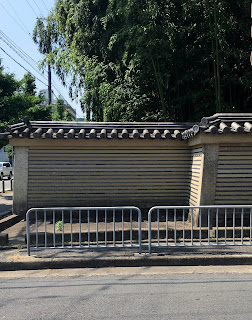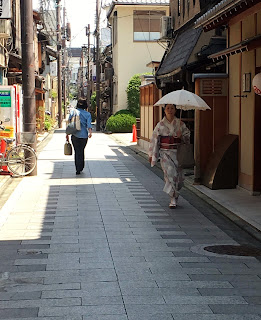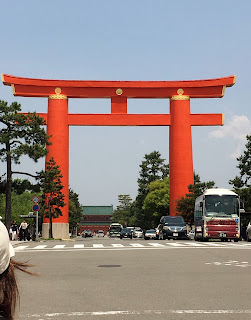 |
| It's a great day for a bike ride! |
I also learn you're supposed to use arm signals when riding the bike. I have yet to see a single rider do that in Tokyo, but I notice other bikers in Kyoto signaling, too.
 |
| I would get lost in this intersection! |
 |
| Another temple? Really? |
 |
| missing northeast corner |
We cross the Kamo River several times. It's before the rainy season, so the water level is low. Lines are draped above the river to prevent birds from diving in to eat all the fish. The yuka, or outdoor decks, are built by restaurants for the summertime. Eating outdoors by the river helps to make the humidity not seem as bad. Maybe that's the case in the evening, but now it's sunny, in the 80s, and there's no shade. I would find it very uncomfortable.
 |
| The geiko names are "behind" the lantern. |
 |
| The salt captures the "bad stuff" so you're pure when you enter the residence. |
 |
| A real geisha (geiko!) |
 |
| The reed "wall" on the upper balcony provides additional privacy. |
 We then stop by a bridge that was in the movie Memoirs of a Geisha, but I don't remember the scene. It's supposed to be popular for wedding photos, but apparently it's an inauspicious day for marriages, because no couples are there (our guide said normally there's 5-6). It gives us a chance to get some photos, though! Steve's never seen the movie, and it's been years since I read the book/saw the movie, so we may have to watch it.
We then stop by a bridge that was in the movie Memoirs of a Geisha, but I don't remember the scene. It's supposed to be popular for wedding photos, but apparently it's an inauspicious day for marriages, because no couples are there (our guide said normally there's 5-6). It gives us a chance to get some photos, though! Steve's never seen the movie, and it's been years since I read the book/saw the movie, so we may have to watch it. |
| The cars help put the size in perspective! |
We stop by Heian Jingu Shrine, which has a giant torii gate entrance. It was built to celebrate the 1100th anniversary of the capital's foundation in Kyoto. It's going to be a long time before anything in the US celebrates its 1100th anniversary! The shrine was built in 1895, so it's one of the "youngest" religious structures we've seen. It's dedicated to the first and last emperors who ruled from Kyoto, so you see the imperial chrysanthemum symbol on different items.
 |
| 16 petals = imperial seal. No one else can use that symbol! |
 |
| Bonus points if you find the turtle! |

No comments:
Post a Comment